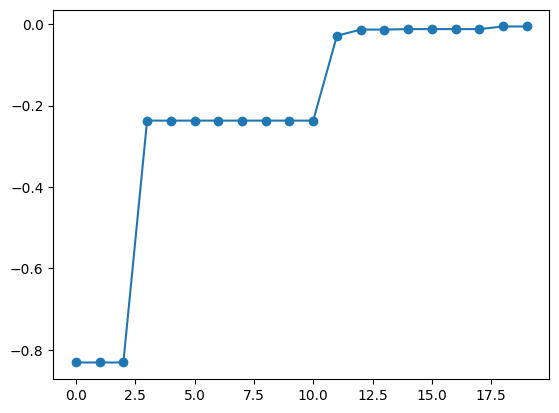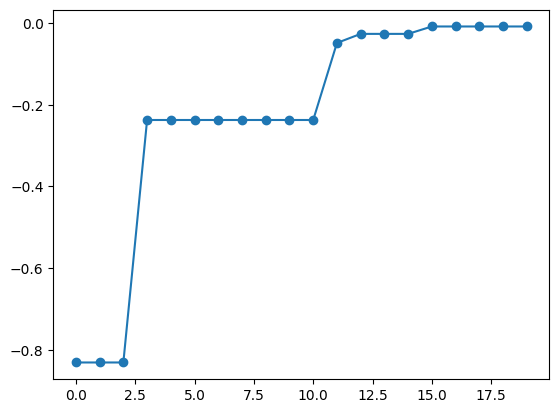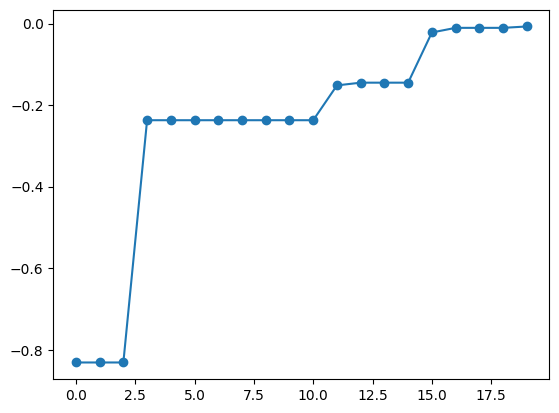この jupyter notebook ファイルは ISSP Data Repository (develop branch) から入手できます。
連続空間での最適化
ここまでのチュートリアルでは、特徴量空間を離散化してベイズ最適化を実行してきました。 PHYSBOは連続量のまま最適化することもできます。
連続空間で獲得関数を最大化するためのアルゴリズムとして、ランダムサーチが実装されています。 また、最適化ライブラリとして、ODAT-SEを使用することもできます。 これは pip を用いてインストール可能です。
python3 -m pip install odatse
基本的な使い方
まずは必要なモジュールをインポートします。
[1]:
import numpy as np
import physbo
import matplotlib.pyplot as plt
最適化したい関数 simulator について、離散版では候補点の番号 action を入力として受け取りましたが、連続版では座標 x を直接入力として受け取ります。 x は \(N\times D\) の配列で、\(N\) は計算するデータの数、\(D\) は特徴量の次元数です。
[2]:
def simulator(x):
return -np.sum(x**2, axis=1)
特徴量空間の下限と上限をそれぞれ min_X と max_X で指定します。
[3]:
min_X = [-2.0, -2.0]
max_X = [2.0, 2.0]
連続空間版の Policy クラスは physbo.search.range.Policy です。 コンストラクタには min_X と max_X を指定します。 また、離散空間版と同様に mpi4py.MPI.Comm を comm として渡すことで並列実行が可能です。 set_seed メソッドを用いて乱数のシードを設定することもできます。
[4]:
seed = 31415
policy = physbo.search.range.Policy(min_X=min_X, max_X=max_X)
policy.set_seed(seed)
一度 Policy クラスを作成してからは、離散空間版と同様の流れで最適化を実行できます。 まずは、サロゲートモデルを学習するための初期訓練データを作成するために、 random_search を実行します。
[5]:
policy.random_search(max_num_probes=10, simulator=simulator)
0001-th step: f(x) = -0.831185 (action=[0.58327442 0.70069668])
current best f(x) = -0.831185 (best action=[0.58327442 0.70069668])
0002-th step: f(x) = -5.914186 (action=[1.88281594 1.53921746])
current best f(x) = -0.831185 (best action=[0.58327442 0.70069668])
0003-th step: f(x) = -4.352756 (action=[1.63626337 1.29437187])
current best f(x) = -0.831185 (best action=[0.58327442 0.70069668])
0004-th step: f(x) = -0.237057 (action=[-0.05316112 0.48397432])
current best f(x) = -0.237057 (best action=[-0.05316112 0.48397432])
0005-th step: f(x) = -0.488353 (action=[ 0.57404985 -0.39852174])
current best f(x) = -0.237057 (best action=[-0.05316112 0.48397432])
0006-th step: f(x) = -2.441356 (action=[1.50087645 0.43442582])
current best f(x) = -0.237057 (best action=[-0.05316112 0.48397432])
0007-th step: f(x) = -3.440784 (action=[-1.57320004 -0.98276443])
current best f(x) = -0.237057 (best action=[-0.05316112 0.48397432])
0008-th step: f(x) = -3.452632 (action=[-1.85812001 0.00465691])
current best f(x) = -0.237057 (best action=[-0.05316112 0.48397432])
0009-th step: f(x) = -0.764532 (action=[ 0.46977882 -0.73745485])
current best f(x) = -0.237057 (best action=[-0.05316112 0.48397432])
0010-th step: f(x) = -1.850471 (action=[-0.63939092 -1.20068727])
current best f(x) = -0.237057 (best action=[-0.05316112 0.48397432])
[5]:
<physbo.search.range._history.History at 0x10ab79f90>
次に、 bayes_search でベイズ最適化を実行します。
[6]:
res = policy.bayes_search(max_num_probes=10, simulator=simulator, score="EI")
Start the initial hyper parameter searching ...
Done
Start the hyper parameter learning ...
0 -th epoch marginal likelihood 14.586042968393608
50 -th epoch marginal likelihood 14.234874815492589
100 -th epoch marginal likelihood 14.063504009485191
150 -th epoch marginal likelihood 13.916750623078872
200 -th epoch marginal likelihood 13.772691286779533
250 -th epoch marginal likelihood 13.633003306706154
300 -th epoch marginal likelihood 13.499200854053448
350 -th epoch marginal likelihood 13.371932369305028
400 -th epoch marginal likelihood 13.251396114620245
450 -th epoch marginal likelihood 13.137551699926508
500 -th epoch marginal likelihood 13.030228562473354
Done
0011-th step: f(x) = -5.026362 (action=[-1.03592362 1.98827161])
current best f(x) = -0.237057 (best action=[-0.05316112 0.48397432])
0012-th step: f(x) = -0.028634 (action=[0.1327553 0.10492853])
current best f(x) = -0.028634 (best action=[0.1327553 0.10492853])
0013-th step: f(x) = -0.013414 (action=[0.07031902 0.09202588])
current best f(x) = -0.013414 (best action=[0.07031902 0.09202588])
0014-th step: f(x) = -0.057856 (action=[0.23418776 0.05488579])
current best f(x) = -0.013414 (best action=[0.07031902 0.09202588])
0015-th step: f(x) = -0.012249 (action=[ 0.110677 -0.00028234])
current best f(x) = -0.012249 (best action=[ 0.110677 -0.00028234])
0016-th step: f(x) = -0.015602 (action=[0.12295699 0.02198239])
current best f(x) = -0.012249 (best action=[ 0.110677 -0.00028234])
0017-th step: f(x) = -0.026756 (action=[0.11124983 0.11991566])
current best f(x) = -0.012249 (best action=[ 0.110677 -0.00028234])
0018-th step: f(x) = -0.025519 (action=[0.13646757 0.08304057])
current best f(x) = -0.012249 (best action=[ 0.110677 -0.00028234])
0019-th step: f(x) = -0.005797 (action=[0.07576489 0.00754463])
current best f(x) = -0.005797 (best action=[0.07576489 0.00754463])
0020-th step: f(x) = -0.032290 (action=[0.09645697 0.15161167])
current best f(x) = -0.005797 (best action=[0.07576489 0.00754463])
bayes_search 関数の返り値 res にはベイズ最適化の過程が保存されています。 export_sequence_best_fx メソッドを用いることで、各ステップでの最適化結果を取得できます。
[7]:
best_fx, best_X = res.export_sequence_best_fx()
plt.plot(best_fx, "o-")
[7]:
[<matplotlib.lines.Line2D at 0x10af52d50>]

獲得関数の最適化アルゴリズム
獲得関数の最適化として、デフォルトではランダムサーチが行われます。つまり、 nsamples = 1000 個の候補点をランダムに選び、その中で最も獲得関数が大きい点を選びます。 nsamples の値を変更する場合には、 physbo.search.optimizer.random.Optimizer を用います。 例えば、 nsamples = 100 にしたい場合は、次のように random_optimizer を作成し、 bayes_search 関数の optimizer キーワードに渡します。
[8]:
random_optimizer = physbo.search.optimize.random.Optimizer(min_X=min_X, max_X=max_X, nsamples=100)
policy = physbo.search.range.Policy(min_X=min_X, max_X=max_X)
policy.set_seed(seed)
policy.random_search(max_num_probes=10, simulator=simulator)
res = policy.bayes_search(max_num_probes=10, simulator=simulator, score="EI", optimizer=random_optimizer)
best_fx, best_X = res.export_sequence_best_fx()
plt.plot(best_fx, "o-")
0001-th step: f(x) = -0.831185 (action=[0.58327442 0.70069668])
current best f(x) = -0.831185 (best action=[0.58327442 0.70069668])
0002-th step: f(x) = -5.914186 (action=[1.88281594 1.53921746])
current best f(x) = -0.831185 (best action=[0.58327442 0.70069668])
0003-th step: f(x) = -4.352756 (action=[1.63626337 1.29437187])
current best f(x) = -0.831185 (best action=[0.58327442 0.70069668])
0004-th step: f(x) = -0.237057 (action=[-0.05316112 0.48397432])
current best f(x) = -0.237057 (best action=[-0.05316112 0.48397432])
0005-th step: f(x) = -0.488353 (action=[ 0.57404985 -0.39852174])
current best f(x) = -0.237057 (best action=[-0.05316112 0.48397432])
0006-th step: f(x) = -2.441356 (action=[1.50087645 0.43442582])
current best f(x) = -0.237057 (best action=[-0.05316112 0.48397432])
0007-th step: f(x) = -3.440784 (action=[-1.57320004 -0.98276443])
current best f(x) = -0.237057 (best action=[-0.05316112 0.48397432])
0008-th step: f(x) = -3.452632 (action=[-1.85812001 0.00465691])
current best f(x) = -0.237057 (best action=[-0.05316112 0.48397432])
0009-th step: f(x) = -0.764532 (action=[ 0.46977882 -0.73745485])
current best f(x) = -0.237057 (best action=[-0.05316112 0.48397432])
0010-th step: f(x) = -1.850471 (action=[-0.63939092 -1.20068727])
current best f(x) = -0.237057 (best action=[-0.05316112 0.48397432])
Start the initial hyper parameter searching ...
Done
Start the hyper parameter learning ...
0 -th epoch marginal likelihood 14.586042968393608
50 -th epoch marginal likelihood 14.234874815492589
100 -th epoch marginal likelihood 14.063504009485191
150 -th epoch marginal likelihood 13.916750623078872
200 -th epoch marginal likelihood 13.772691286779533
250 -th epoch marginal likelihood 13.633003306706154
300 -th epoch marginal likelihood 13.499200854053448
350 -th epoch marginal likelihood 13.371932369305028
400 -th epoch marginal likelihood 13.251396114620245
450 -th epoch marginal likelihood 13.137551699926508
500 -th epoch marginal likelihood 13.030228562473354
Done
0011-th step: f(x) = -3.969688 (action=[-0.55371092 1.91392061])
current best f(x) = -0.237057 (best action=[-0.05316112 0.48397432])
0012-th step: f(x) = -0.048301 (action=[ 0.09981879 -0.19579904])
current best f(x) = -0.048301 (best action=[ 0.09981879 -0.19579904])
0013-th step: f(x) = -0.026065 (action=[0.00582793 0.16134044])
current best f(x) = -0.026065 (best action=[0.00582793 0.16134044])
0014-th step: f(x) = -0.029637 (action=[-0.03315978 0.16893146])
current best f(x) = -0.026065 (best action=[0.00582793 0.16134044])
0015-th step: f(x) = -6.287502 (action=[ 1.84812961 -1.69467382])
current best f(x) = -0.026065 (best action=[0.00582793 0.16134044])
0016-th step: f(x) = -0.007927 (action=[ 0.06895685 -0.05632176])
current best f(x) = -0.007927 (best action=[ 0.06895685 -0.05632176])
0017-th step: f(x) = -0.011240 (action=[0.10157691 0.03036993])
current best f(x) = -0.007927 (best action=[ 0.06895685 -0.05632176])
0018-th step: f(x) = -0.060419 (action=[ 0.1940892 -0.15082425])
current best f(x) = -0.007927 (best action=[ 0.06895685 -0.05632176])
0019-th step: f(x) = -0.016852 (action=[-0.12738362 0.02501082])
current best f(x) = -0.007927 (best action=[ 0.06895685 -0.05632176])
0020-th step: f(x) = -0.093609 (action=[0.12668816 0.27849452])
current best f(x) = -0.007927 (best action=[ 0.06895685 -0.05632176])
[8]:
[<matplotlib.lines.Line2D at 0x10ba4fd90>]

physbo.search.optimize.random.Optimizer 以外のオプティマイザを使うことで、ランダムサーチ以外の最大化アルゴリズムを利用できます。 PHYSBOでは、ODAT-SEを用いるオプティマイザ physbo.search.optimize.odatse.Optimizer を提供しています。このライブラリは
「exchange」: レプリカ交換モンテカルロ法
「pamc」: ポピュレーションアニーリングモンテカルロ法
「minsearch」: Nelder-Mead法
「mapper」: グリッドサーチ
「bayes」: ベイズ最適化
の5つのアルゴリズムを用いて最適化問題を解くことができます。 ODAT-SEのアルゴリズムやハイパーパラメータは、ODAT-SEの入力ファイルの [algorithm] セクションに相当する辞書を用いて指定します。
physbo.search.optimize.odatse.default_alg_dict 関数でこの辞書の雛形ができるので、必要に応じてパラメータを修正します。
[9]:
import physbo.search.optimize.odatse
odatse_alg_dict = physbo.search.optimize.odatse.default_alg_dict(min_X=min_X,
max_X=max_X,
algorithm_name="exchange")
# show the default parameters for the exchange algorithm
odatse_alg_dict
[9]:
{'name': 'exchange',
'seed': 12345,
'param': {'min_list': array([-2., -2.]),
'max_list': array([2., 2.]),
'step_list': array([0.04, 0.04])},
'exchange': {'numsteps': 1000,
'numsteps_exchange': 10,
'Tmin': 0.1,
'Tmax': 10.0,
'Tlogspace': True,
'nreplica_per_proc': 10}}
odatse_alg_dict を physbo.search.optimize.odatse.Optimizer に渡してオプティマイザ odatse_optimizer を作成します。 これを random_optimizer と同様に bayes_search 関数の optimizer キーワードに渡すことで、ODAT-SEを用いた最適化を行えます。
[10]:
odatse_optimizer = physbo.search.optimize.odatse.Optimizer(alg_dict=odatse_alg_dict)
policy = physbo.search.range.Policy(min_X=min_X, max_X=max_X)
policy.set_seed(seed)
policy.random_search(max_num_probes=10, simulator=simulator)
res = policy.bayes_search(max_num_probes=10,
simulator=simulator,
optimizer=odatse_optimizer,
score="EI")
0001-th step: f(x) = -0.831185 (action=[0.58327442 0.70069668])
current best f(x) = -0.831185 (best action=[0.58327442 0.70069668])
0002-th step: f(x) = -5.914186 (action=[1.88281594 1.53921746])
current best f(x) = -0.831185 (best action=[0.58327442 0.70069668])
0003-th step: f(x) = -4.352756 (action=[1.63626337 1.29437187])
current best f(x) = -0.831185 (best action=[0.58327442 0.70069668])
0004-th step: f(x) = -0.237057 (action=[-0.05316112 0.48397432])
current best f(x) = -0.237057 (best action=[-0.05316112 0.48397432])
0005-th step: f(x) = -0.488353 (action=[ 0.57404985 -0.39852174])
current best f(x) = -0.237057 (best action=[-0.05316112 0.48397432])
0006-th step: f(x) = -2.441356 (action=[1.50087645 0.43442582])
current best f(x) = -0.237057 (best action=[-0.05316112 0.48397432])
0007-th step: f(x) = -3.440784 (action=[-1.57320004 -0.98276443])
current best f(x) = -0.237057 (best action=[-0.05316112 0.48397432])
0008-th step: f(x) = -3.452632 (action=[-1.85812001 0.00465691])
current best f(x) = -0.237057 (best action=[-0.05316112 0.48397432])
0009-th step: f(x) = -0.764532 (action=[ 0.46977882 -0.73745485])
current best f(x) = -0.237057 (best action=[-0.05316112 0.48397432])
0010-th step: f(x) = -1.850471 (action=[-0.63939092 -1.20068727])
current best f(x) = -0.237057 (best action=[-0.05316112 0.48397432])
Start the initial hyper parameter searching ...
Done
Start the hyper parameter learning ...
0 -th epoch marginal likelihood 14.586042968393608
50 -th epoch marginal likelihood 14.234874815492589
100 -th epoch marginal likelihood 14.063504009485191
150 -th epoch marginal likelihood 13.916750623078872
200 -th epoch marginal likelihood 13.772691286779533
250 -th epoch marginal likelihood 13.633003306706154
300 -th epoch marginal likelihood 13.499200854053448
350 -th epoch marginal likelihood 13.371932369305028
400 -th epoch marginal likelihood 13.251396114620245
450 -th epoch marginal likelihood 13.137551699926508
500 -th epoch marginal likelihood 13.030228562473354
Done
name : exchange
seed : 12345
param.min_list : [-2. -2.]
param.max_list : [2. 2.]
param.step_list : [0.04 0.04]
exchange.numsteps: 1000
exchange.numsteps_exchange: 10
exchange.Tmin : 0.1
exchange.Tmax : 10.0
exchange.Tlogspace: True
exchange.nreplica_per_proc: 10
complete main process : rank 00000000/00000001
end of run
start separateT 0
Best Result:
rank = 0
step = 592
walker = 7
fx = -0.08724730012318738
x1 = -0.6632394188413887
x2 = 1.2992687470140636
0011-th step: f(x) = -2.127986 (action=[-0.66323942 1.29926875])
current best f(x) = -0.237057 (best action=[-0.05316112 0.48397432])
name : exchange
seed : 12345
param.min_list : [-2. -2.]
param.max_list : [2. 2.]
param.step_list : [0.04 0.04]
exchange.numsteps: 1000
exchange.numsteps_exchange: 10
exchange.Tmin : 0.1
exchange.Tmax : 10.0
exchange.Tlogspace: True
exchange.nreplica_per_proc: 10
complete main process : rank 00000000/00000001
end of run
start separateT 0
Best Result:
rank = 0
step = 3
walker = 2
fx = -0.15122627226282423
x1 = 0.21383031999250043
x2 = 0.3254993696726256
0012-th step: f(x) = -0.151673 (action=[0.21383032 0.32549937])
current best f(x) = -0.151673 (best action=[0.21383032 0.32549937])
name : exchange
seed : 12345
param.min_list : [-2. -2.]
param.max_list : [2. 2.]
param.step_list : [0.04 0.04]
exchange.numsteps: 1000
exchange.numsteps_exchange: 10
exchange.Tmin : 0.1
exchange.Tmax : 10.0
exchange.Tlogspace: True
exchange.nreplica_per_proc: 10
complete main process : rank 00000000/00000001
end of run
start separateT 0
Best Result:
rank = 0
step = 792
walker = 4
fx = -0.045043047258201775
x1 = 0.2884566379550175
x2 = 0.24852525678914614
0013-th step: f(x) = -0.144972 (action=[0.28845664 0.24852526])
current best f(x) = -0.144972 (best action=[0.28845664 0.24852526])
name : exchange
seed : 12345
param.min_list : [-2. -2.]
param.max_list : [2. 2.]
param.step_list : [0.04 0.04]
exchange.numsteps: 1000
exchange.numsteps_exchange: 10
exchange.Tmin : 0.1
exchange.Tmax : 10.0
exchange.Tlogspace: True
exchange.nreplica_per_proc: 10
complete main process : rank 00000000/00000001
end of run
start separateT 0
Best Result:
rank = 0
step = 9
walker = 2
fx = -0.02392460498257011
x1 = 0.24246152789117092
x2 = 0.31119117438511995
0014-th step: f(x) = -0.155628 (action=[0.24246153 0.31119117])
current best f(x) = -0.144972 (best action=[0.28845664 0.24852526])
name : exchange
seed : 12345
param.min_list : [-2. -2.]
param.max_list : [2. 2.]
param.step_list : [0.04 0.04]
exchange.numsteps: 1000
exchange.numsteps_exchange: 10
exchange.Tmin : 0.1
exchange.Tmax : 10.0
exchange.Tlogspace: True
exchange.nreplica_per_proc: 10
complete main process : rank 00000000/00000001
end of run
start separateT 0
Best Result:
rank = 0
step = 9
walker = 2
fx = -0.020446511277702712
x1 = 0.24246152789117092
x2 = 0.31119117438511995
0015-th step: f(x) = -0.155628 (action=[0.24246153 0.31119117])
current best f(x) = -0.144972 (best action=[0.28845664 0.24852526])
name : exchange
seed : 12345
param.min_list : [-2. -2.]
param.max_list : [2. 2.]
param.step_list : [0.04 0.04]
exchange.numsteps: 1000
exchange.numsteps_exchange: 10
exchange.Tmin : 0.1
exchange.Tmax : 10.0
exchange.Tlogspace: True
exchange.nreplica_per_proc: 10
complete main process : rank 00000000/00000001
end of run
start separateT 0
Best Result:
rank = 0
step = 552
walker = 2
fx = -0.07481182997481856
x1 = 0.13244261916217667
x2 = 0.06615306139761785
0016-th step: f(x) = -0.021917 (action=[0.13244262 0.06615306])
current best f(x) = -0.021917 (best action=[0.13244262 0.06615306])
name : exchange
seed : 12345
param.min_list : [-2. -2.]
param.max_list : [2. 2.]
param.step_list : [0.04 0.04]
exchange.numsteps: 1000
exchange.numsteps_exchange: 10
exchange.Tmin : 0.1
exchange.Tmax : 10.0
exchange.Tlogspace: True
exchange.nreplica_per_proc: 10
complete main process : rank 00000000/00000001
end of run
start separateT 0
Best Result:
rank = 0
step = 369
walker = 7
fx = -0.02747368281669843
x1 = 0.08963724279512796
x2 = -0.04990899825183725
0017-th step: f(x) = -0.010526 (action=[ 0.08963724 -0.049909 ])
current best f(x) = -0.010526 (best action=[ 0.08963724 -0.049909 ])
name : exchange
seed : 12345
param.min_list : [-2. -2.]
param.max_list : [2. 2.]
param.step_list : [0.04 0.04]
exchange.numsteps: 1000
exchange.numsteps_exchange: 10
exchange.Tmin : 0.1
exchange.Tmax : 10.0
exchange.Tlogspace: True
exchange.nreplica_per_proc: 10
complete main process : rank 00000000/00000001
end of run
start separateT 0
Best Result:
rank = 0
step = 870
walker = 3
fx = -0.025961091903193047
x1 = 0.14544088137927852
x2 = 0.043151524528747376
0018-th step: f(x) = -0.023015 (action=[0.14544088 0.04315152])
current best f(x) = -0.010526 (best action=[ 0.08963724 -0.049909 ])
name : exchange
seed : 12345
param.min_list : [-2. -2.]
param.max_list : [2. 2.]
param.step_list : [0.04 0.04]
exchange.numsteps: 1000
exchange.numsteps_exchange: 10
exchange.Tmin : 0.1
exchange.Tmax : 10.0
exchange.Tlogspace: True
exchange.nreplica_per_proc: 10
complete main process : rank 00000000/00000001
end of run
start separateT 0
Best Result:
rank = 0
step = 808
walker = 1
fx = -0.009096193960224805
x1 = -0.1277048769917059
x2 = -0.01838854551819171
0019-th step: f(x) = -0.016647 (action=[-0.12770488 -0.01838855])
current best f(x) = -0.010526 (best action=[ 0.08963724 -0.049909 ])
name : exchange
seed : 12345
param.min_list : [-2. -2.]
param.max_list : [2. 2.]
param.step_list : [0.04 0.04]
exchange.numsteps: 1000
exchange.numsteps_exchange: 10
exchange.Tmin : 0.1
exchange.Tmax : 10.0
exchange.Tlogspace: True
exchange.nreplica_per_proc: 10
complete main process : rank 00000000/00000001
end of run
start separateT 0
Best Result:
rank = 0
step = 909
walker = 2
fx = -0.022643697695937905
x1 = 0.08090134843314561
x2 = 0.02494348508299006
0020-th step: f(x) = -0.007167 (action=[0.08090135 0.02494349])
current best f(x) = -0.007167 (best action=[0.08090135 0.02494349])
[11]:
best_fx, best_X = res.export_sequence_best_fx()
plt.plot(best_fx, "o-")
[11]:
[<matplotlib.lines.Line2D at 0x10ba6ca50>]

[ ]: